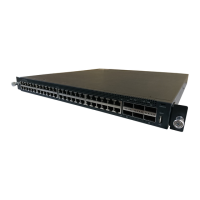FUJITSU PSWITCH User’s Guide
142 December/2018
3.1.9.20. VRF Lite
With the Virtual Routing/Forwarding (VRF) Lite feature, one router can act as
multiple routers. Each virtual router manages its own routing domain. Specifically,
each virtual router maintains its own IP route, routing interface, and host entry, so
each virtual router can make its own routing decision independently from other
virtual routers . Multiple virtual routing tables may contain routes to specific
destinations. Network administrators can associate a subset of the router's
interfaces with each virtual router. The router routes the packet according to the
virtual routing table associated with the input interface of the packet. Each
interface can be associated with at most one virtual router.
OSPF, Ping, Traceroute, and BGP applications are compatible with virtual routers.
To establish a VRF, there must be available space in the routing table.
Network management includes the ability to manage the
switch via CLI and SNMP. DNI Network management is
supported only via the default router. Administrators cannot log
into the switch and manage the switch via one of the IP
addresses on the non-default VR.
The service port and the network port are always associated
with the default router, so the customers are able to manage
the switch via these interfaces.
Only the default router can be managed via SNMP.
The Authentication, Authorization, and Accounting protocols
include services such as the RADIUS client and the TACAVS+
client. DNI supports these services only on the default router.
Ping and traceroute clients are supported in the Virtual Router
context. Other protocols are supported only in the default
router. These includes the SNTP client, DNS and sFlow.
Loopback interfaces with IPv4 prefixes are supported in the
Virtual Router.
Loopback interfaces with IPv6 prefixes can be configured only in
the default router.
IP unnumbered interface cannot be part of non-default VRF
instance. This feature is supported only in the default router.
OSPF for IPv4 is supported in Virtual Router.
OSPFv3 protocol is supported only in the default router.
Both RIP and RIPng are not supported in the Virtual Router.
The VRRP protocol is supported in the Virtual Router context.

